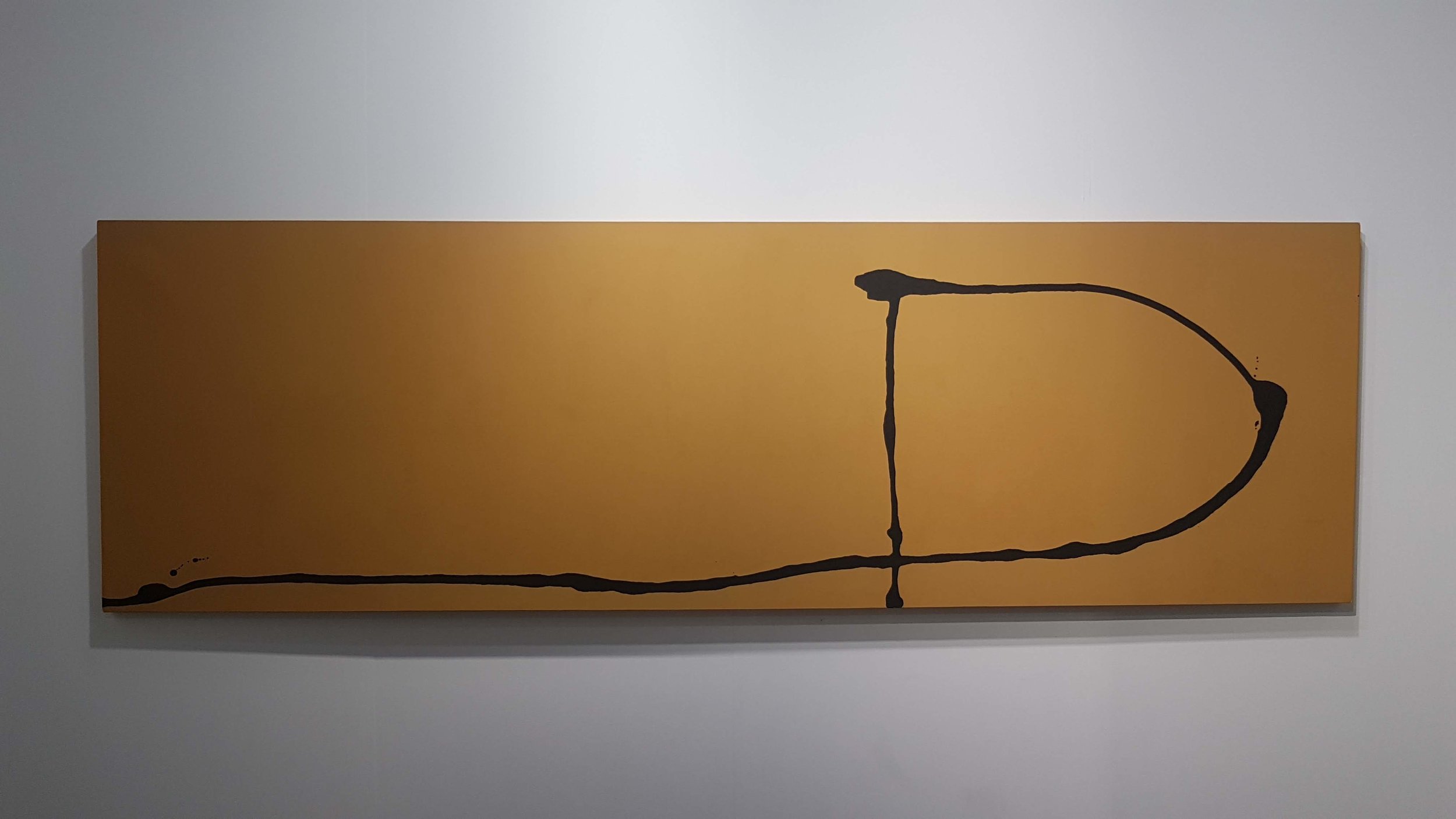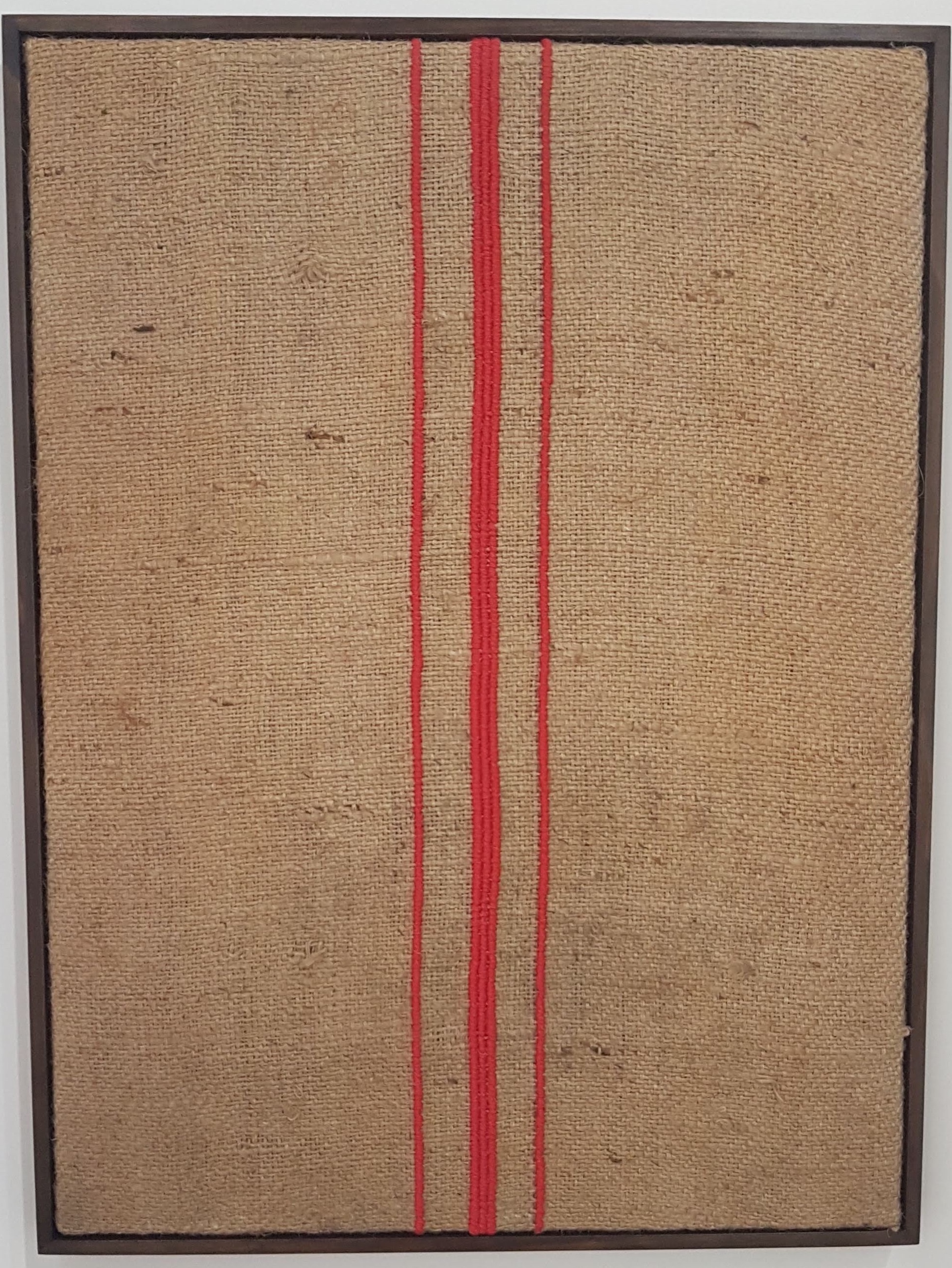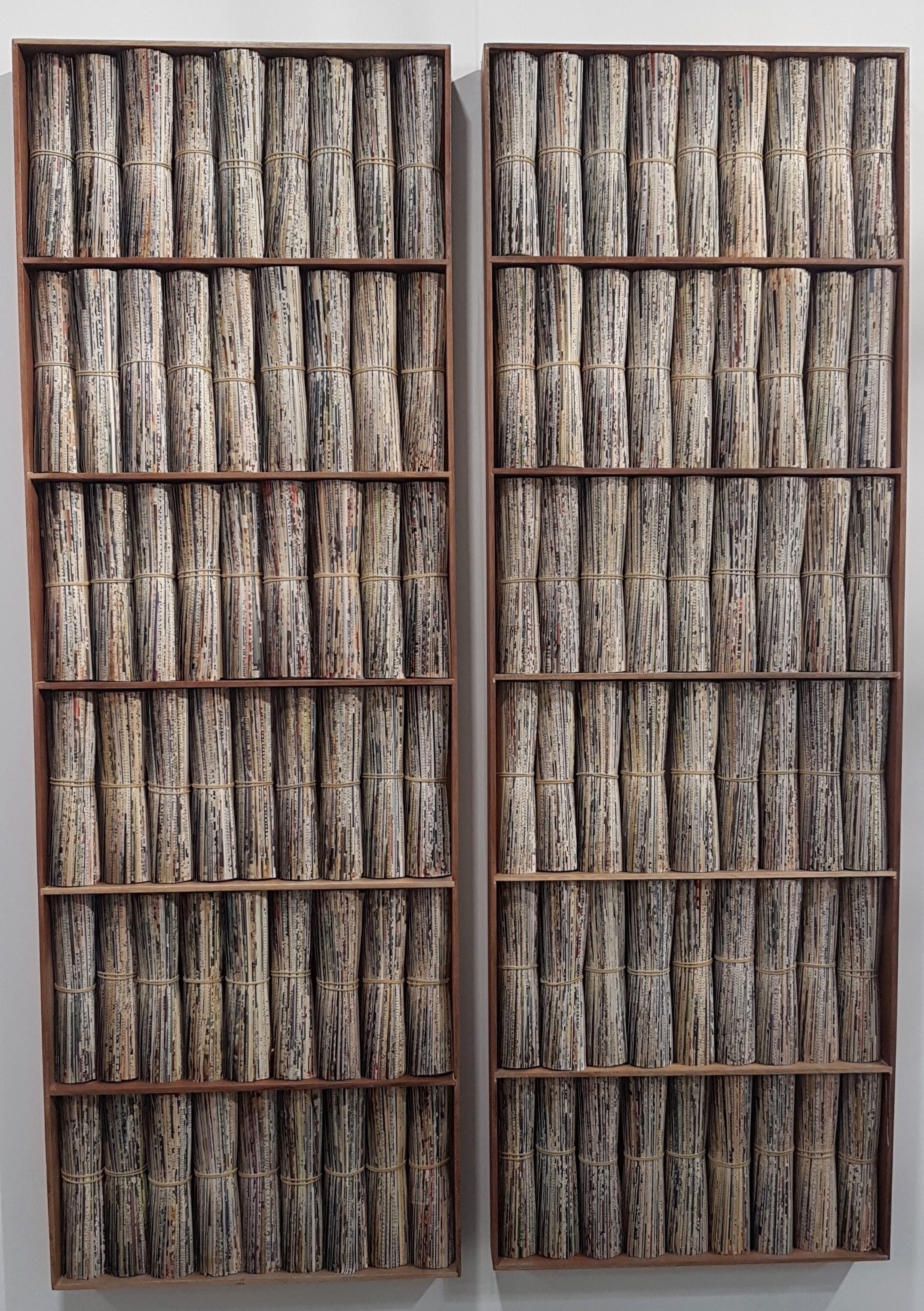Minimal Conceptual Latin Art in Art Basel Miami Beach --- Galeria Luisa Strina
It was refreshing to see some minimal and conceptual art amidst a sea of explosive colors and loud gestures, albeit some were great works, at Art Basel Miami Beach. For that matter, I was most inspired by Galeria Luisa Strina from Sao Paulo at the Convention Center. Its booth was well-curated; each piece informed the other at every turn, with contained passion, simple forms and quiet confidence.
Galeria Luisa Strina, one of the oldest and most influential galleries in Brazil, was the first Latin-American gallery invited to participate in the Art Basel Fair in 1992. In its 44 years of history, Strina has introduced diverse exponents of what later would be called Geração 70, such as Cildo Meireles, and worked with many leading Brazilian artists to develop their international careers, such as Alexandre da Cunha, Fernanda Gomes, Marepe, etc.
Robert Rauschenberg, Tempo Clay Piece 1 & Piece 4, 1972, fired clay with screen printed decal, soil patina and platium luster. Photo credit to the writer.
Galeria Strina’s booth mixed works by esteemed postwar artists and younger rising stars who are all from Latin countries, except American artist Robert Rauschenberg. His wall series Tempa Clay (1972) resembled crushed cardboard boxes down to small details of tears, staples, post labels and folding marks, etc. This practice of using one material to mimic a completely different texture of material has become increasingly popular with many artists. Jeff Koons is the most prominent one, but Rauschenberg started it a decade earlier than Koons.
View from East entrance of Galeria Lusia Strina booth at Art Basel Miami Beach, photo courtesy to Galeria Lusia Strina.
Strina booth had open entrances on East and West sides with a column in the middle. On the South wall by the East entrance, the Gallery mounted Cildo Meireles’ wall sculpture of various sizes of crosses in croten steel from his Descala (Breakdown) series, which in 2003 was selected to exhibit at the Venice Biennale. Since the late 1960s, Meireles has created sculptures and installations that are often interactive, drawing attention to the physical, psychological, social, and political being in space and time.I saw his large scale installation Babel (2001) at Venice Biennale in 2009 and was dazzled by the tower of hundreds of radios, each audible and tuned to a station of different language to evoke resonances of the Tower of Babel in the Bible.
Booth view of Cildo Meireles’ Descala 1b (Breakdown 1b, 2002) and Laura Lima’s Anonymous (2016). Photo credit to the writer.
Meireles’ piece was juxtaposed at 90 degree with Clarissa Tossin’s New Grammar of Forms series (2018) that colonized the floor, air and the small wall of the column. This piece was inspired by the history of the Brazilian port city Manaus, that was the center of the rubber boom in the late 19th century. It has become a Free Trade Zone since 1957 and now hosts the manufacturing plants of Apple, Coca-Cola and Honda Motorcycles, etc. Tossin crafted replicas of iPhones and Coca-Cola bottles out of terra cotta, exploring the impact of industrialization and globalization on the material culture of the indigenous groups in the area. For the last two days the gallery hung Laura Lima’s wall piece, Anonymous (2016) on the column wall, with black torn fabric loosely covering layered wood pieces. Lima is recognized for her site-specific installations and consistently reinventing the viewer’s encounter with her work, skillfully considering the nature of perception, social relations, and human behavior, while exploring the boundaries of perception in dreams and fiction, in everyday reality and the absurd.
Mexican artist Pedro Reyes’s bronze sculpture, Spiral Nude (2018), was installed in the middle of the Entrance. Reyes has been acknowledged internationally for large-scale projects that address current social and political issues. His immersive exhibition Doomocracy in Brooklyn, New York, was a 'political house of horrors' marking the confluence of Halloween and the 2016 U.S. presidential election.
Anna Maria Maiolino, Untitled, 1995, Acrylic on canvas, 40 5/8 x 130 5/8 inches. Photo credit to the writer.
On the North wall of the entrance, Leonilson’s abstract painting, Untitled (1986), on un-stretched canvas is characteristic of his usual practice. Though he died young, Leonilsonis a legendary figure in Brazil’s art world for his poetic vision during the AIDS epidemic of the 1980s and the early 1990s. Next to his work, stood out Anna Maria Maiolino’s beautiful wall sculpture, Untitled from Cobrinhas [Little Snakes] (1993/2013). The rows of overlapping white cylinder shapes are made of plaster with an acrylic resin varnish. From a distance, one could easily believed they were soft and pliable cushions. This work was sold quickly, so the gallery hung another of her piece, Untitled, from Desenhos/Objetos series (1976-2009): a white wooden box with a slashed
Anna Maria Maiolino, Untitled, from Desenhos/Objetos series (1976-2009), paper and thread in wooden box, 28.2 x 40 x 3.6 inches. Photo credit to the writer.
“wound” on the top and stitch-like threads on the inside of the box. A slash is an opening of ‘another’ space that aims at totality and becomes the continuity of the cut surface. I was totally in love with Maiolino’s work, so was thrilled to see her large scale painting, Untitled (1995) at gallery Bergamine and Gomide’s booth. A single black acrylic line across the majestic muted golden brown canvas that appeared as a D with a long tail extended at the bottom. After a few minutes of staring, the “D” looked like a perky breast with nipple in the middle.
Alexandre da Cunha, Fair Trade XXIII, 2016, embroidery on burlap sack in collaboration with Luisa Strina, 30.7 x 22.8 x 1.6 inches. Photo credit to the writer.
Alexandre da Cunha’s embroidery of red vertical lines on an unpainted burlap sack, Fair Trade XXIII (2016), was as rustic as it was elegant. Like many artists in this booth, Da Cunha often uses everyday or found objects, which remain identifiable within the abstract assemblages, to make freestanding, wall-mounted, and architectural sculptures. The artist once summarized: “By highlighting specific aspects of objects that surround us, I impose a possible entry for them in what is known as the art world.”
Jarbas Lopes, Magazines, 2018, journal, elastic, wood, 70.9 x 70.9 x 3.9 inches, photo credit to the writer.
On the South wall near the West entrance of the booth was Jarbas Lopes’ wall piece, Magazines (2018), with numerous rolled magazines made of cut newspapers lined up on wooden shelves. Viewers can pick up any magazine and read the contents.Lopes’s work focuses on the idea of accessibility of aesthetic experience and social interaction.
West entrance of Galeria Lusia Strina booth at Art Basel Miami Beach, photo credit to the writer.
In the middle of the West booth, Marepe’s wood and acrylic wire sculpture Embutido XI (2017) was hanging from the ceiling like an architectural model. Marepe is best known for his minimalist wood and metal sculptures that question his roots: the traditions and culture of his native region of Bahia in Brazil. The notion of poverty, colonialism and globalism are the artist's main concerns.
Underneath Marepe’s piece was Marcius Galan’s small sculpture, Line weight II (2018), a concrete cube with merino woolthreads attached on its two sides as if to connect it to the floor. Galan is excellent at using natural material and simple lines to play with perspective. In fact, I was mesmerized by hiswork Three sections (2010) exhibited at CIFO Miami, a few years ago. Using only Wood, floor wax and paint on the wall, it looked like we saw through three layers of wall-to-wall green glass placed at different angles.
Marcius Galan, Three Section (2010), CIFO, Miami.
In the center of the West entrance, the gallery laid Gabriel Sierra’s painted wooden divider, Space Separator (2009), and Leonor Antunes’ sculpture of nylon thread net hanging over wood frame with a long title: The line is so thin that the eye, although armed with a magnifying glass, imagine instead of seeing it (2013). Columbia artist Sierra uses instinctive yet thoughtful interventions with everyday objects, presenting viewers with a keen interest in the social codes of our living environment and how these norms can be changed or overturned through the manipulation of architectural dynamics. Portugueseartist Leonor Antunes is recognized for her conceptual sculptures that borrow from vernacular craftsman traditions from Portugal, Mexico and South America. Antunes learns from the construction principles behind rational designs and reduces reality to a geometric abstraction. I have seen her works at the Venice Biennale in 2017.
Fernanda Gomes is acknowledged in the art world for her small and large-scale installations that combine painting and sculpture practices. Gallerina Strina displayed two of her assemblages on a partition wall. On the left were two white canvases attached but not aligned to each other at the bottom, and on the right was a small unpainted three-sided wood frame mounted on the wall vertically at a 90-degree angle. Both pieces areplaying with light and shadows, especially the second one, with the shadow acting as the fourth frame. At different angles, the shadows fell in different places in various lengths. “Perspectives revealed in the movement by the beholder,” as the artist said.
Luisa Strina Galleria also exhibited Alfredo Jaar’s lightbox, Lygia Pape’s small wall sculptures, Mira Schendel’s paintings, and more. It was the limitation of the fair booth that the gallery could not exhibit large scale installations, interactive or performance pieces by many of its brilliant artists. Nonetheless, with seemingly nonchalant charm, these unassuming bricolagesdelivered an internal emotional wallop and made a lasting impression.
Galeria Lusia Strina booth at Art Basel Miami Beach, photo credit to the writer.









